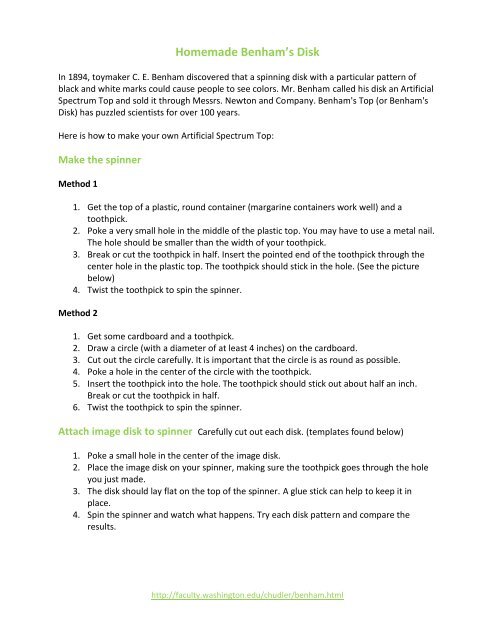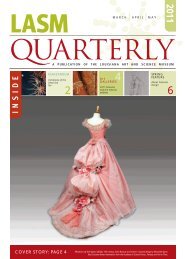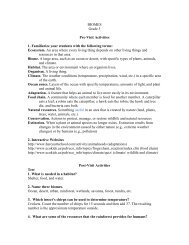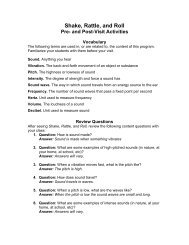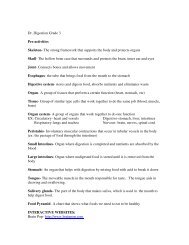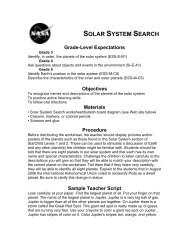Create successful ePaper yourself
Turn your PDF publications into a flip-book with our unique Google optimized e-Paper software.
<strong>Homemade</strong> Benham’s <strong>Disk</strong><br />
In 1894, toymaker C. E. Benham discovered that a spinning disk with a particular pattern of<br />
black and white marks could cause people to see colors. Mr. Benham called his disk an Artificial<br />
Spectrum Top and sold it through Messrs. Newton and Company. <strong>Benham's</strong> Top (or <strong>Benham's</strong><br />
<strong>Disk</strong>) has puzzled scientists for over 100 years.<br />
Here is how to make your own Artificial Spectrum Top:<br />
Make the spinner<br />
Method 1<br />
1. Get the top of a plastic, round container (margarine containers work well) and a<br />
toothpick.<br />
2. Poke a very small hole in the middle of the plastic top. You may have to use a metal nail.<br />
The hole should be smaller than the width of your toothpick.<br />
3. Break or cut the toothpick in half. Insert the pointed end of the toothpick through the<br />
center hole in the plastic top. The toothpick should stick in the hole. (See the picture<br />
below)<br />
4. Twist the toothpick to spin the spinner.<br />
Method 2<br />
1. Get some cardboard and a toothpick.<br />
2. Draw a circle (with a diameter of at least 4 inches) on the cardboard.<br />
3. Cut out the circle carefully. It is important that the circle is as round as possible.<br />
4. Poke a hole in the center of the circle with the toothpick.<br />
5. Insert the toothpick into the hole. The toothpick should stick out about half an inch.<br />
Break or cut the toothpick in half.<br />
6. Twist the toothpick to spin the spinner.<br />
Attach image disk to spinner Carefully cut out each disk. (templates found below)<br />
1. Poke a small hole in the center of the image disk.<br />
2. Place the image disk on your spinner, making sure the toothpick goes through the hole<br />
you just made.<br />
3. The disk should lay flat on the top of the spinner. A glue stick can help to keep it in<br />
place.<br />
4. Spin the spinner and watch what happens. Try each disk pattern and compare the<br />
results.<br />
http://faculty.washington.edu/chudler/benham.html
Benham’s <strong>Disk</strong> Templates<br />
Instructions:<br />
Cut out each disk carefully. Push a toothpick through the center of each disk and<br />
then slide the toothpick through the middle of the plastic lid or cardboard.<br />
Break the toothpick in half for the best results. The blank disk without a pattern<br />
(lower right) is for you to design yourself. Use a black marker to draw on the<br />
white half. Attach your disk to a spinner and see if it works.<br />
http://faculty.washington.edu/chudler/benham.html
Special Notes for Using the Spinner<br />
1. The colors are seen best at slow speeds (between 3-5 rotations/second). Try different<br />
speeds!<br />
2. It is important that your spinner can spin at slow speeds. Therefore, make sure your<br />
spinner is centered properly. Make sure you place the toothpick in the center of the<br />
spinner.<br />
3. Experiment!<br />
• Change the lighting conditions. Test it outside in sunlight; test it under different<br />
types of light (incandescent, fluorescent, etc.)<br />
• Change the pattern. Make your own pattern using the blank disk. Use a black marker<br />
to draw a pattern or series of arcs on the white side of the disk.<br />
• Change the color of the disk. What happens if you use a blue disk?<br />
• Spin the spinner clockwise and counterclockwise.<br />
Theories for How the Benham’s <strong>Disk</strong> Works<br />
The retina of the eye is composed of two types of light-sensitive receptors: cones and rods.<br />
Cones are important for color vision and for seeing in bright light. There are three types of<br />
cones, each of which is most sensitive to a particular wavelength of light. Rods are<br />
important for seeing in low light.<br />
It is possible that the colors seen in spinning Benham disks are the result of changes that<br />
occur in the retina and other parts of the visual system. For example, the spinning disks may<br />
activate neighboring areas of the retina differently. In other words, the black and white<br />
areas of the disk stimulate different parts of the retina. This alternating response may cause<br />
some type of interaction within the nervous system that generates colors.<br />
Another theory is that different types of cones take different amounts of time to respond<br />
and that they stay activated for different amounts of time. Therefore, when you spin the<br />
disk, the white color activates all three types of cones, but then the black deactivates them.<br />
The activation/deactivation sequence causes an imbalance because the different types of<br />
cones take different amounts of time to respond and to stay on. This imbalance in<br />
information going to the brain results in colors.<br />
Neither of these theories explains the colors of <strong>Benham's</strong> disk completely, and the reason<br />
behind the illusion remains unsolved.<br />
http://faculty.washington.edu/chudler/benham.html


